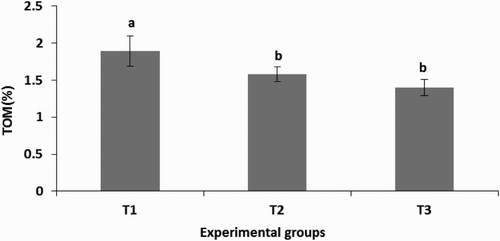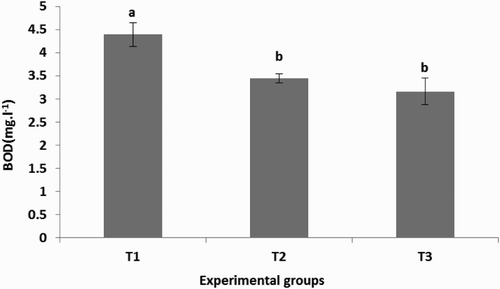ABSTRACT
A polyculture system composed of western white shrimp, Litopenaeus vannamei and Mullet, Mugil cephalus, was established to create favourable biological condition and improve shrimp growth. Totally, nine earthen ponds of 600 m2 (three treatments with three replicates) were prepared in the Gwadar area (located in the coastal area of Oman Sea, southeast of Iran) for our experiment. The L. vannamei post-larvae (PLs) (average body weight: 0.007 ± 0.001 g) were stocked at a density of 20 PLs m−2 in each experimental pond. After 40 days of storage, mullets with size of 20–50 cm were stocked at densities of 0 (T1), 2 (T2) and 4 (T3) fish per 100 m2 of ponds, respectively. The growth parameters (including: specific growth rate, mean weight), food conversion ratio (FCR) and survival rate (SR) of shrimps were measured during the experiment. After 107 days of the experiment, the highest shrimp biomass was obtained in T3 (212 kg) and T1 yielded the lowest biomass (187 kg). The mean body weight of each shrimp was 18.4 and 16.23 g in T3 and T1 , respectively (P < 0.05). The SR and FCR did not show significant differences between treatments (P > 0.05). In conclusion, the present experiment demonstrated that polyculture of western white shrimp with mullet improves growth and subsequently the production of western shrimp.
1. Introduction
Polyculture consists of adding one or more subordinate species to the culture system of a main species (Lanza-Espino et al. Citation1991). In many countries, polyculture of fish and other marine and brackish water shrimps has been conducted especially in Southeast Asia. In the past decade, studies about the crustacean polyculture have increased, demonstrating in some cases that it is not only profitable, but also a sustainable activity, both in freshwater and marine systems (Irz & Mckenzie Citation2003). Integrated culture is considered as an effective strategy to minimize waste in the farm system. Several benefits have been reported in shrimp polyculture systems when using fish and other aquatic organisms as subordinate species, despite the fact that polyculture is not yet a common practice (Martinez-Porchas et al. Citation2010). Moreover, some authors believed that adding secondary species improves the performance of the main cultured organism (Wang et al. Citation1998; Tian et al. Citation2001). Belton and Little (Citation2008) demonstrated that integrated aquaculture practices, such as polyculture, are good alternatives for reducing contamination also, it can contribute to minimizing the environmental impact of farm effluents, particularly those related to nitrogenous wastes, which are further converted into toxic metabolites. The main reason for this is that some subordinate species can feed on and assimilate most of the wastes generated from shrimp aquaculture. Some authors reported that shrimp culture with mullet and milkfish had benefits in the removal of nitrogenous wastes from the shrimp ponds (Eldani & Primavera Citation1981; Marichamy & Rajapackram Citation1982). Different aquatic species, for example bivalvia (Pacific oyster, Crassostrea gigas and black clam Chione fluctifraga) and fish (Oreochromis urolepis hornorum) (Martinez-Cordova & Martinez-Porchas Citation2006; Tendencia et al. Citation2006), have been co-cultured with penaeid shrimps which improved shrimp production. The results of polyculture white shrimp with C. gigas and C. fluctifraga showed that ‘the presence of mollusks had a beneficial effect on the productive performance of shrimp' (Martinez-Cordova & Martinez-Porchas Citation2006, p. 74). The selection of the best fish candidates for polyculture and considering an appropriated design culture system are the most important points for successful polyculture of shrimp with other species. Mullet is potentially good candidates for polyculture with shrimp due to the acceptable commercial value and high resistance to wide range of temperature and salinity. In many countries mullets are cultured in association with fish and other organisms as polyculture. The rearing of grey mullets in combination with milkfish, Indian major carps and shrimps in the coastal tanks of West Bengal has been described by Pakrasi et al. (Citation1975). Mullet is a filter feeder, which usually swims near the top of the water as school and swallows the scum of the water surface (Anil et al. Citation2010). Also, Anil et al. (Citation2010) investigated the economic feasibility of polyculture of the giant tiger shrimp with mullet. All these reports clearly indicate that shrimp performance is enhanced by the presence of a secondary species. The aim of the current study was to gain optimal water condition and shrimp growth in culture of Litopenaeus vannamei when mullet is used as secondary species in a polyculture system.
2. Materials and methods
Experiment was carried out in nine earthen ponds of 600 m2 situated at the northern site of shrimp farm in the Gwadar–Chabahar area, Iran. After pond preparation, post-larvae (PLs) of white shrimp (mean body weight: 0.007 ± 0.001 g) were purchased from a commercial hatchery and acclimatized inside 300 L tanks. After acclimatization, PLs were stocked at a density of 20 PLs m−2 in the experimental ponds in the early evening. After stocking, the chemical fertilizers such as urea and diammonium phosphorate were applied to each pond depending on the production condition (or phytoplankton biomass) of water. The production condition was monitored by secchi disk visibility to keep the optimum water colour and transparency of 30–40 cm during the experiment (Boyd Citation1992). Mullets were caught by a gill net (mesh size: 1 cm) from the Gwadar bay and transferred with a 300 L tank to farm location. After disinfecting of mullets with formalin (200 ppm), they were stocked at densities of 0, 2 and 4 individuals to each 100 m2 of ponds respectively at day 40 of experiment. The growth parameters of shrimps were measured by sampling of 15–20 shrimps from each pond every 10 days. Total biomass, growth rates, mean weight and food conversion ratio (FCR) were calculated according to procedure of Chanratchakool et al. (Citation1993) and Brock and Main (Citation1994). During the course of the experiment, shrimps were fed three times in a day with a commercial pellet (Havorash Company) with different sizes (4001–4006 type) depending on their growth stages. For feeding, two feeding circular tray (diameter = 40 cm) were placed in each pond, and the pellets distributed on these trays. The decreasing feeding rate changed from 15% to 2% of body weight of shrimps with the growth of shrimps. During the experiment (107 days) water quality parameters, including salinity, temperature, pH (by a pH metre: Model 6 APX15/C) WTW-330i) and dissolved oxygen (by an oxygen metre: OxyGouard), were measured daily. pH and dissolved oxygen (mg−l) were measured two times in day (i.e. morning and afternoon times) according to Trivedy and Goel (Citation1986), whereas salinity (ppt) was measured by a refractometer (WTW-320) one time in day according to Katznelson (Citation2004). Total organic matter (TOM) (%) was assayed according to Holme and Mcintyr (Citation1984). The NH3 (mg L −1) concentrations were measured by a spectrophotometer according to Koroleff (Citation1976). Also, biological oxygen demand (BOD5 ) was assayed by a BOD meter (Model Camlab Company, Cambridge, UK).
The SPSS software was used for data analysis. Normality of data was investigated according to the Kolmogorov Smirnov test, but because percentage data did not have a normal distribution, proportional data were converted by angular transformation (arcsin√p). One-way analysis of variance was employed to analyse data. Then, means were compared by Tukey's test.
3. Results
The mean of daily specific growth rate (SGR) (), total shrimp biomass () and mean weight of each shrimp () were significantly higher in the polyculture groups (T2, T3) compared to monoculture treatment (T1) (P < 0.05). Also, there are no significant differences between polyculture and monoculture in terms of FCR () and SR () of shrimps (P > 0.05). Throughout the present experiment, the water concentrations of NH3 () and also TOM () content of sediments in polyculture ponds were significantly lower than monoculture (P > 0.05). The mean values of water BOD5 in polyculture ponds were significantly lower than monoculture (P < 0.05) ().
Figure 2. The total shrimp biomass after 120 days rearing for all experimental groups. Means with different superscripts are significantly different (P < 0.05).
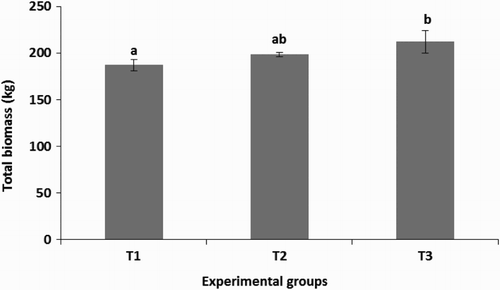
Figure 3. The mean weight of each shrimp during 120 days rearing for all experimental groups. Means with different superscripts are significantly different (P < 0.05).
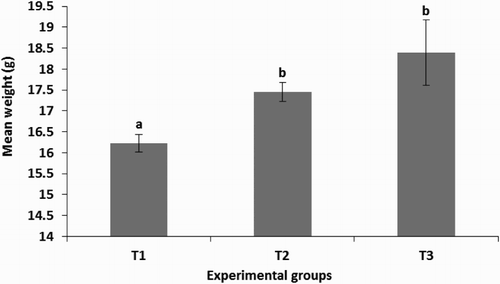
Figure 4. The values of mean FCR during 120 days rearing for all experimental groups. Means with different superscripts are significantly different (P < 0.05).

Figure 5. The values of SR during 120 days rearing for all experimental groups. Means with different superscripts are significantly different (P < 0.05).
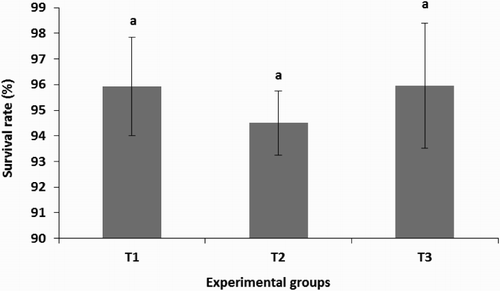
Figure 6. The mean values of water NH3 during 120 days rearing for all experimental groups. Means with different superscripts are significantly different (P < 0.05).
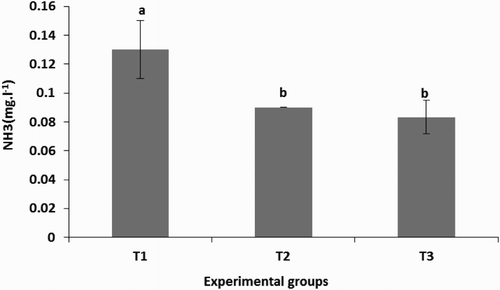
4. Discussion
We used a direct polyculture system, that is, mixing of two species in the same pond or aquaculture unit without partitioning. This type of polyculture does not require significant extra economical or human effort in investment because the secondary species are simply added within the same space of the main species. Thus, there is no necessity for more space. As well as, our results showed that the growth rate, mean weight and total biomass of harvested shrimps were significantly higher in the polyculture of shrimp and mullet compared with monoculture system after 4 months culture days. Also, there are no differences between polyculture and monoculture in terms of FCR and survival rate (SR) of shrimps. These results indicate that the polyculture system of shrimp and mullet is economically more efficient than monoculture. Generally, many benefits have been achieved in shrimp polyculture systems when using fish, bivalves and seaweeds. The benefits include the diminution of ecological impacts and maintenance of water quality which subsequently improve total biomass of shrimp (Muangkeow et al. Citation2007; Troell et al. Citation2009). For example, polyculture of Chanos chanos and Penaeus monodon increased the mean weight of harvested shrimps (Tampy et al. Citation1988).
The growth of shrimp is generally dependent on feed availability and water quality (Zhen-Xiong et al. Citation2001; Muangkeow et al. Citation2007). In this study, the source of feed for shrimp was feed concentrate which was distributed equally in experimental systems according to the standard plan. Thus, the better shrimp harvests from polyculture ponds probably return to factors other than artificial food, factors such as natural productivity and water quality of ponds. Throughout the present experiment, the water concentrations of NH3 and also TOM content of sediments of the polyculture ponds were lower than monoculture. Tian et al. (Citation2001) investigated the water quality in a closed polyculture system containing Chinese penaeid shrimp, Penaeus chinensis) with Taiwanese red tilapia, Oreochromis mossambicus × Oreochromis niloticus and constricted tagelus, Sinonovacula constricta). They found that bacteria and TOM were significantly reduced in the polyculture system compared with monoculture. In addition, total nitrogen levels were measured in sediments of the polyculture ponds and found to be 39.76% lower than those of monoculture sediments. Several studies showed that polyculture can contribute to minimizing the environmental impact of farm effluents, particularly those related to nitrogenous wastes, which are further converted into toxic metabolites (Martinez-Porchas et al. Citation2010). The main reason for this is that some subordinate species can feed on and assimilate most of the wastes generated from shrimp aquaculture. A higher efficiency of nitrogen utilization has been observed in polyculture systems compared with monoculture systems (Zhen-Xiong et al. Citation2001), with a consequent decrease in nitrogen excess, improvement in water quality and diminution of the environmental impact resulting from effluent discharges. In the present study, the lower levels of water NH3 and TOM content of sediments in the polyculture may be due to the continual feeding of mullets on accumulated TOMs in the bottom of ponds. Also, it was demonstrated that the stocking density of 4 fish per 100 m−2 has more efficiency than density of 2 fish per 100 m−2 in reduction of water NH3 and TOM content of sediments.
Our results showed that total mean of BOD5 in the polyculture ponds were lower than monoculture. Generally, the addition of a subordinate species into the shrimp culture system increases the oxygen demand because the total biomass of the system has increased and in such a case emergency or supplemental aeration is required (Danaher et al. Citation2007). Guocai et al. (Citation2000) argued that phytoplankton and sediment demand high amounts of oxygen in shrimp polyculture systems. Nonetheless, subordinate species can consume organic matter and microalgae, reducing the oxygen demand of the entire system (Tian et al. Citation2001) as the total means of BOD5 in polyculture of western white shrimp and mullet were lower than monoculture ponds. In the present study, the values of FCR and SGR of shrimps from polyculture were approximately similar to monoculture. This concluded that mullet–shrimp polyculture is economically feasible, although the FCR and SGR values were not better than monoculture.
Acknowledgements
The authors are sincerely grateful to the staff of Offshore Fisheries Research Center, Chabahar for their suggestions and providing of facilities. Also, the authors express their sincere appreciation to the people who gave their time, advice, and support to this study.
Disclosure statement
No potential conflict of interest was reported by the authors.
References
- Anil SK, Gunalan B, Jetani KL, Kuldeep Trivedi G, Soundarapandian P. 2010. Determine the economic feasibility of the polyculture system (giant tiger shrimp and mullet). Afr J Basic Appl Sci. 2:124–127.
- Belton B, Little D. 2008. The development of aquaculture in central Thailand: domestic demand versus export-led production. J Agrar Change. 8:123–143. doi: 10.1111/j.1471-0366.2007.00165.x
- Brock AJ, Main KL. 1994. A guide to the common problems and disease of cultured Littopenaeus vannamei. Honolulu, HI: The Oceanic Institute; p. 90–94.
- Boyd C. 1992. Water quality management for pond fish culture (4th ed.). New York: Elsevier Science Publishers B.V.
- Chanratchakool P, Ball JF, Limsuwan C. 1993. Health management in shrimp pond. Journjak, Bongkok, Thailand: Aquatic Animal Health Research Institute, Kasetsart University; p. 41–47.
- Danaher JJ, Tidwell JH, Coyle SD, Dasgupta S, Zimba PV. 2007. Effects of two densities of caged mono sex Nile tilapia, Oreochromis niloticus, on water quality, phytoplankton populations, and production when polycultured with Macrobrachium rosenbergii in temperate ponds. J World Aquacult Soc. 38:367–382. doi: 10.1111/j.1749-7345.2007.00109.x
- Eldani A, Primavera JH. 1981. Effect of different stocking combinations on growth, production and survival of milk-fish (Chanos chanos Forskal) and prawn (Penaeus monodon Fabricius) in polyculture in brackish water ponds. Aquaculture. 23:59–72. doi: 10.1016/0044-8486(81)90007-7
- Guocai L, Deshang L, Shuanglin D. 2000. Carbon cycle in shrimp polyculture mesocosm. Chin J Oceanol. 18:67–73. doi: 10.1007/BF02842544
- Holme NA, Mcintyre AD. 1984. Methods for the study of marine benthos. IBP Hanol book. No. 16. 2nd ed. Oxford: Blackwell Scientific Publications; p. 387.
- Irz X, Mckenzie V. 2003. Profitability and technical efficiency of aquaculture systems in Pampanga, Philippines. Aquacult Econ Manage. 7:195–211. doi: 10.1080/13657300309380340
- Katznelson R. 2004. Conductivity/salinity/measurement principles and methods. DQM information paper; p. 1–9.
- Koroleff F. 1976. Determination of nutrients. In: Grashof E, Kremling E, editors. Methods of seawater analysis. New York, NY: Verlag Chemie Wenhein; p. 117–181.
- Lanza-Espino G, Lara-Andrade R, Garcia-Calderon JL. 1991. La Acuicultura en Palabras. Mexico city: AGT.
- Marichamy R, Rajapackiam S. 1982. The culture of milkfish, mullet and prawn in experimental marine fish farm at Tuticorin. In: Proceedings of the symposium on coastal aquaculture (vol. 6). Cochin: Marine Biological Association of India; p. 256–265.
- Martinez-Porchas M, Martinez-Cordova LR, Porchas-Cornejo MA, Lopez Elia JA. 2010. Shrimp polyculture: apotentially profitable, sustainable, but uncommon aquacultural practice. Rev Aquacul. 2:73–85. doi: 10.1111/j.1753-5131.2010.01023.x
- Martinez-Cordova LR, Martinez-Porchas M. 2006. Polyculture of Pacific white shrimp, Litopenaeus vannamei, giant oyster, Crassostrea gigas and black clam, Chione fluctifraga inponds in Sonora, Mexico. Aquaculture. 258:321–326. doi: 10.1016/j.aquaculture.2006.03.026
- Muangkeow B, Ikejma K, Powtongsook S, Yi Y. 2007. Effects of white shrimp, Litopenaeus vannamei (Boone), and Nile tilapia, Oreochromis niloticus L., stocking density on growth, nutrient conversion rate and economic return in integrated closed recirculation system. Aquaculture. 269:363–376. doi: 10.1016/j.aquaculture.2007.04.002
- Pakrasi B. Basu BNC, Banerjee R. 1975. Role of grey mullets in polyculture in coastal tanks of West Bengal. Bull Dep Mar Sci Univ Cochin. 7:31–40.
- Tampy DM, Jose S, Mohan MV, Hoya MSI. 1988. Short-term biculture of tiger prawn Penaeus monodon fabricios and milkfish Chanos chanos Forsskal in a low saline pond. The first Indian branch Managalore; p. 139–141.
- Tian X , Li D, Dong S, Yan X, Qi Z , Liu G, Lu J. 2001. An experimental study on closed-polyculture of penaeid shrimp with tilapia and constricted tagelus. Aquaculture. 202:57–71. doi: 10.1016/S0044-8486(01)00559-2
- Tendencia EA, Fermin AC, dela Pena MR, Choresca CH Jr. 2006. Effect of Epinepheluscoioides, Chanos chanos and GIFT tilapia in polyculture with Penaeus monodon on the growth of the luminousbacteria Vibrio harveyi. Aquaculture. 253:48–56. doi: 10.1016/j.aquaculture.2005.06.028
- Trivedy RK, Goel PK. 1986. Chemical and biological methods for water pollution studies. Karad: Environmental Publications; p. 1–52.
- Troell M, Joyce A, Chopin T, Neori A, Buschmann AH, Fang JG. 2009. Ecological engineering in aquaculture – potential for integrated multi-trophic aquaculture (IMTA) in marine offshore systems. Aquaculture. 297:1–9. doi: 10.1016/j.aquaculture.2009.09.010
- Wang J, Li D, Dong S, Wang K, Tian X. 1998. Experimental studies on polyculture in closed shrimp ponds. Aquaculture. 163:11–27. doi: 10.1016/S0044-8486(98)00165-3
- Zhen-Xiong Q, De-Shang L, Man-Ping Z, Shuang-Lin D. 2001. Comparative studies on nitrogen budgets of closed polyculture systems. Chin J Oceanol. 19:233–242. doi: 10.1007/BF02850660


